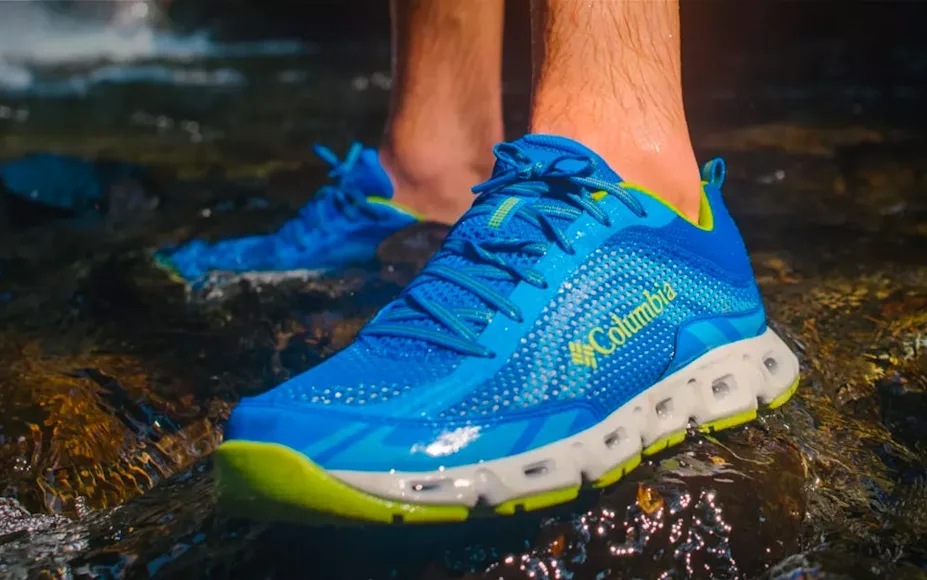_We may earn revenue from the products available on this page and participate in affiliate programs. Learn more ›
_
Best Overall
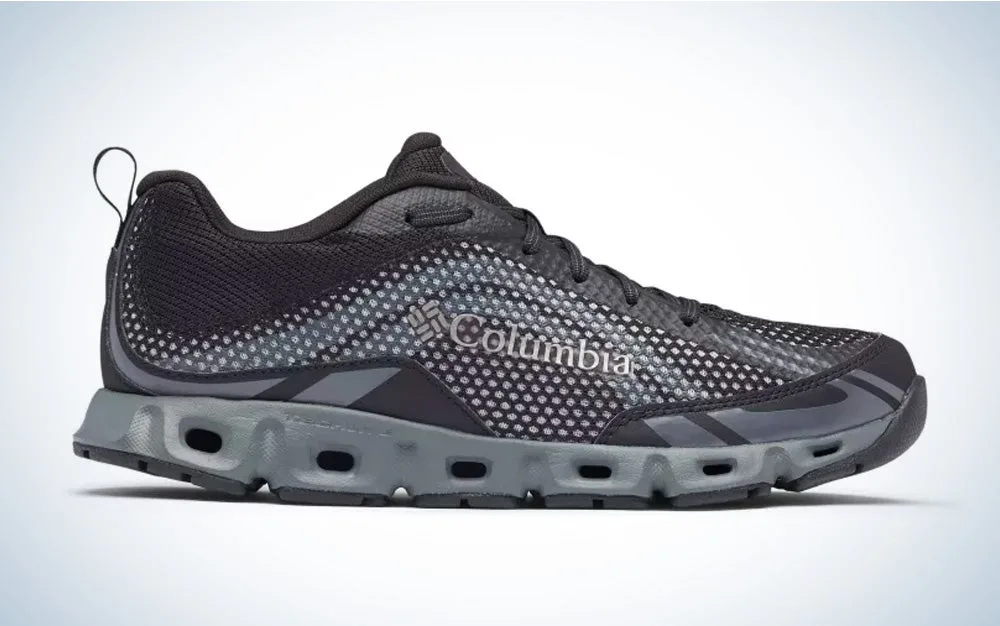
Columbia Drainmaster IV
LEARN MORE
Summary
Sporting a unique side drain and ventilation system, these shoes can seamlessly traverse a range of terrain types.
Pros
Drains water quickly
Protection from rocks and shells
Cushy insole works for hiking
Cons
Slow to Dry
Best for Fishing
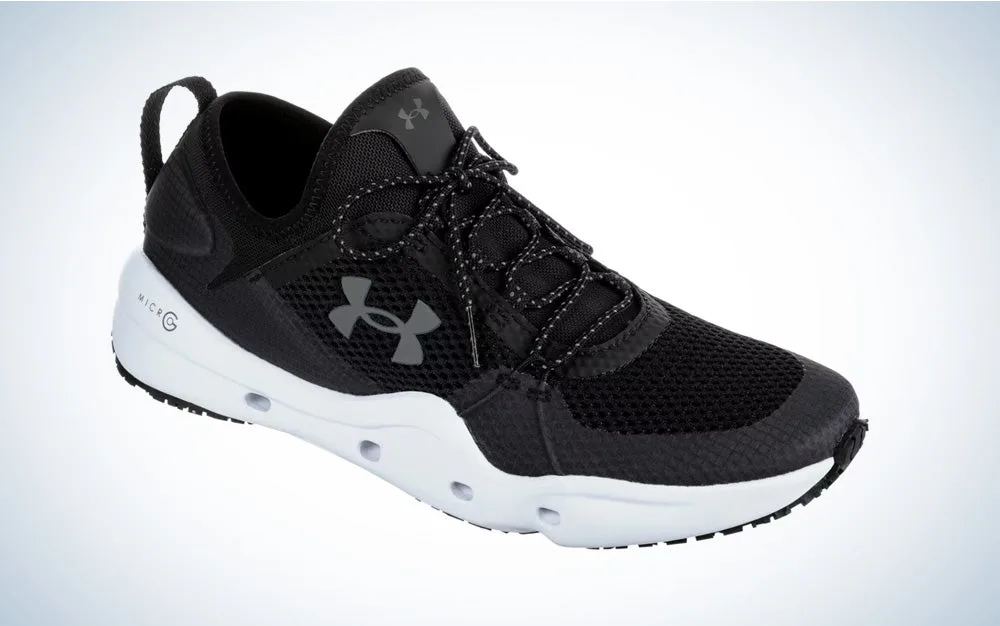
Under Armour Micro G Kilchis
LEARN MORE
Summary
The traditional sneaker look of the Under Armour Kilchis makes these shoes stylish both on the water and off.
Pros
Good arch support
Fast drying
Good traction on slippery surface
Cons
Not the best for hiking
Best for Wide Feet
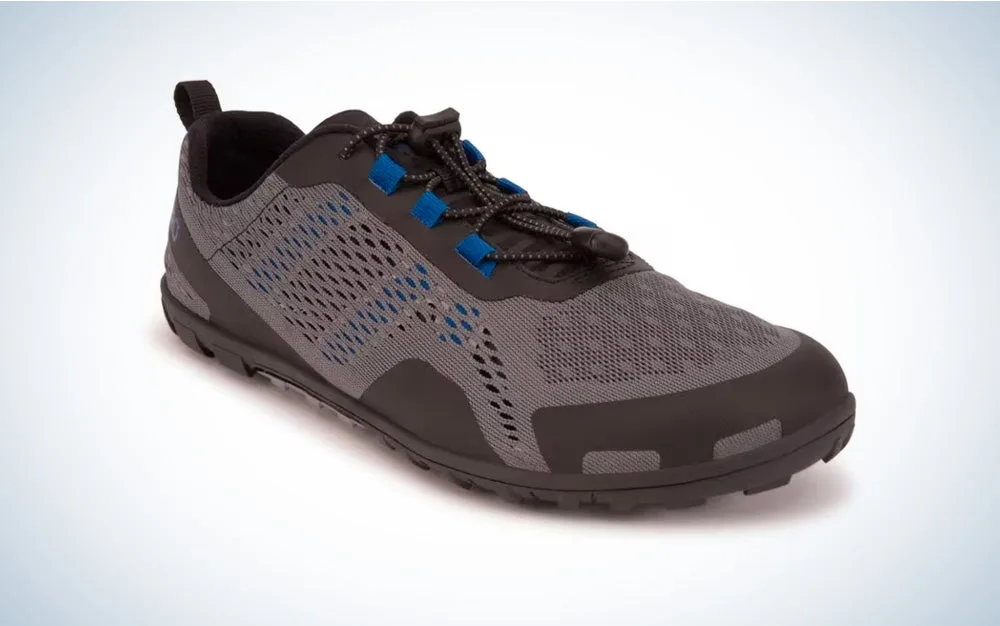
Xero Shoes Aqua X
LEARN MORE
Summary
Xero Shoes make some of the best footwear for wide feet on the market today and the Aqua X provides some of the best comfort.
Pros
Incredibly light
Drain holes help shed water
Wide toe box
Cons
Price tag
Minimalist style is somewhat niche
Men’s water shoes are a worthy investment for anyone planning their summertime adventures. Outdoor activities like kayaking, fishing, and swimming involve lots of water, making footwear designed for it a must. These shoes protect from the unpleasant experience of stepping on a sharp rock or shell hidden under the surface. Not to mention other hidden dangers like lost fish hooks or broken glass. Shoe companies quickly realized there was a market for this style of footwear and have responded with some slick crossover styles and options that cover a whole gamut of uses. These are just a few of the men’s water shoes available now.
Best Overall: Columbia Drainmaker IV
Best for Hiking: Saloman Crossamphibian Swift 2
Best for Rocky Beaches: Astral Loyak
Best for Fishing: Under Armour Micro G Kilchis
Best Budget: Northside Cedar Rapids Hiking Shoe
Best for Wide Feet: Xero Shoes Aqua X
Best for Kayaking: Mishansha Quick Drying
How We Picked the Best Men’s Water Shoes
As an avid fisherman, kayaker, camper, and geocacher, I’ve worn a few brands of water shoes over the years. I’ve learned what makes for a good pair and what doesn’t. Beyond experience with a variety of brands, we also considered some of the following factors when determining the best men’s water shoes:
Insole: Does the insole provide arch support for light hiking or every day walking?
Outsole: Does the shoe have a tread for gripping wet rocks and other slippery surfaces? Does it provide traction for more challenging terrain?
Lacing System: Does this shoe have an elastic band to tighten? Or is this a simple slip-on style?
Drying time: How fast do the shoes dry once the day’s aquatic adventures are over?
Best Men’s Water Shoes: Reviews and Recommendations
Best Overall: Columbia Drainmaker IV
Best Overall

Key Features
Sizes: 7–15
Materials: Synthetic
Weight: 11.75 ounces
Pros
Drains water quickly
Protection from rocks and shells
Cushy insole works for hiking
Cons
Slow to dry
The Columbia Drainmaster’s signature feature is the side midsole ports that add breathability. These ports also allow the shoe to shed water from the interior quickly. That same insole also provides a great deal of cushioning and support that helps these lightweight shoes transition from the water to the hiking trail rather seamlessly. Columbia purposely designed the outer sole’s treads with water in mind, and they provide excellent grip over slippery rocks and docks. Simultaneously, the design for these shoes is rather stylish, making them perfect for everyday wear too.
While many users reviews praise these shoes for their water-shedding capabilities, many also note these shoes are slow to dry. Caution must also be exercised when exposing the shoes to smellier water because many reviews note the shoes took on an odor afterward. Drying these shoes directly in the sun after use helps to avoid that issue.
Best for Hiking: Saloman Crossamphibian Swift 2
Best for Hiking
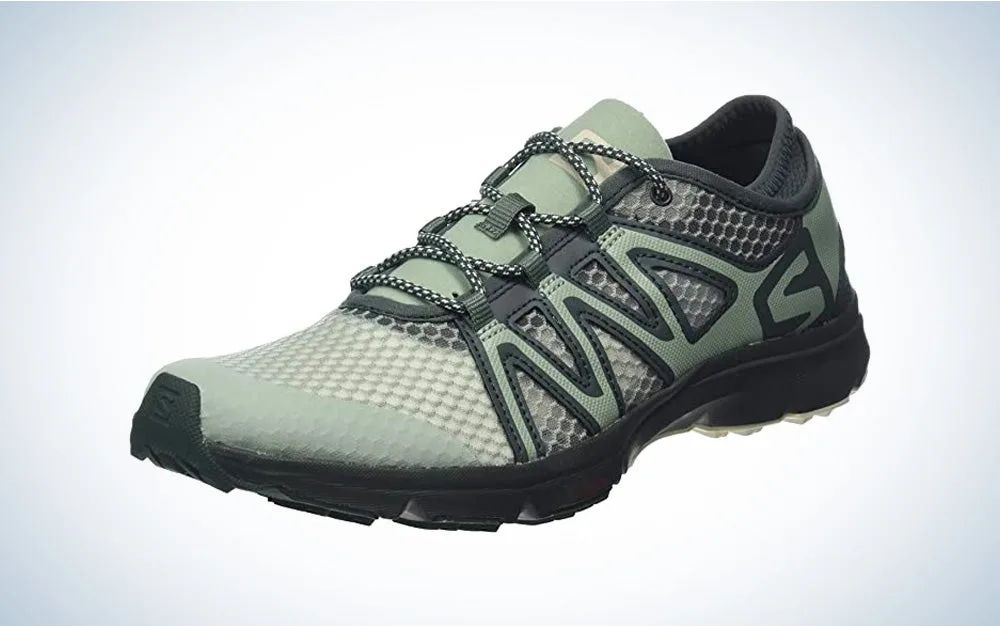
Key Features
Sizes: 7–13
Materials: Mesh and recycled material
Weight: 1.15 pounds
Pros
Sustainable materials
Snug fitting
Outsole has an excellent grip
Cons
Not great for wider feet
Saloman footwear has consistently made our lists of best hiking boots and trail shoes, so it’s only natural a pair of water shoes makes this list. The Crossamphibian Swift 2 shoes are a great pick from a sustainability standpoint because of the recycled plastics and plant fibers used in the main construction. The collapsible heel makes these shoes easy to put on or take off quickly. The outsoles are also impressive, which use a wide pattern that consistently grips wet rocks and other terrain. The tread pattern is also wide enough that it is not going to pick up a ton of debris.
The downside to these shoes is that they are not a great option for wider feet because numerous Amazon reviews have noted
a narrow fit. Another review
notes the material feels a bit thin, so they aren’t the best choice for more overgrown trails with lots of sticks and thorns. However, for most hiking scenarios on established trails that are wetter than normal, these are a great choice.
Best for Rocky Beaches: Astral Loyak
Best for Rocky Beaches
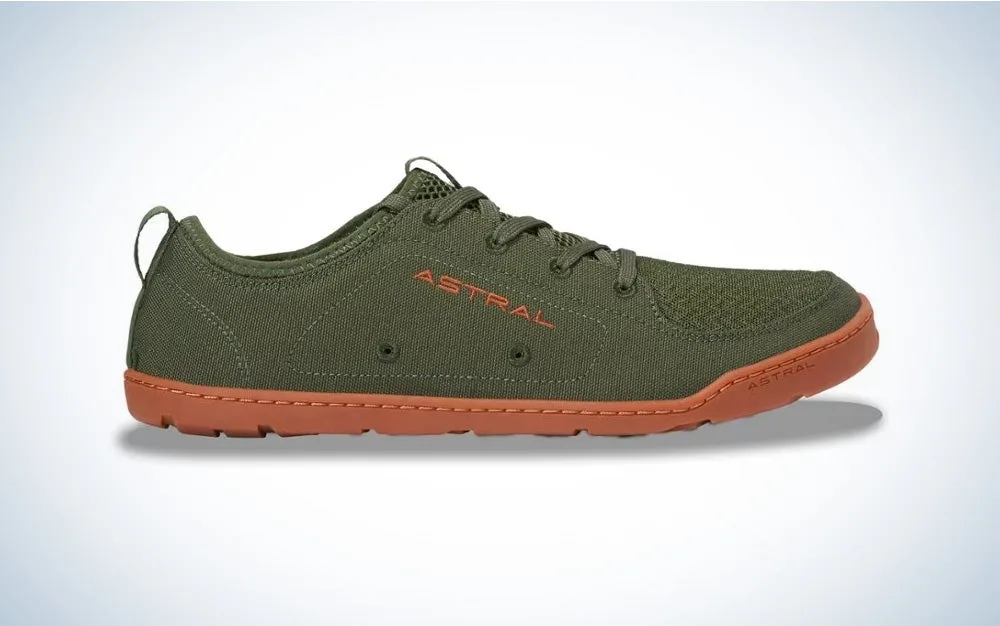
Key Features
Sizes: 8–13
Material: Canvas and mesh
Weight: 14.4 ounces
Pros
Durable material resists abrasion
Excellent tread for slippery surfaces
Versatile enough for hiking
Cons
Expensive
Take a while to break in
Rocky beaches are a special challenge for water shoes because they require a much more durable material. For that reason, the canvas uppers of the Astral Loyak make a lot of sense. The material provides a great deal of abrasion resistance and protection from sands and shells. While the tread on the rubber outsoles might seem a little simplistic, they provide excellent grip on most slippery rocks. Astral put drain holes in the toe and heels of these shoes to allow for faster draining of water. Surprisingly, most of the user reviews note the system works surprisingly well while also not allowing any sand or silt inside.
Although many users report they experienced pain the first time using these shoes. It seems they have a bit of a break-in period before they become more comfortable. The price point is also a little high, but these shoes have an excellent stylish look for more casual wearing too.
Best for Fishing: Under Armour Micro G Kilchis
Best for Fishing

Key Features
Sizes: 8–14
Materials: Synthetic
Weight: 9 ounces each
Pros
Good arch support
Fast drying
Good traction on slippery surfaces
Cons
Not the best for hiking
This shoe retains the aesthetics of a normal tennis or walking shoe while offering a waterproof format. It has a full-length midsole that provides arch support during long days standing on a boat. Most user reviews praise the tread on the outsole for its ability to grip slippery rocks and docks. These are a great choice for shore fishing because they dry fast, so anglers don’t need to worry about getting their feet wet while casting or landing fish. They are also good for casual wear due to their stylish resemblance to regular tennis or running shoes.
Best Budget: Northside Cedar Rapids Hiking Shoe
Best Budget
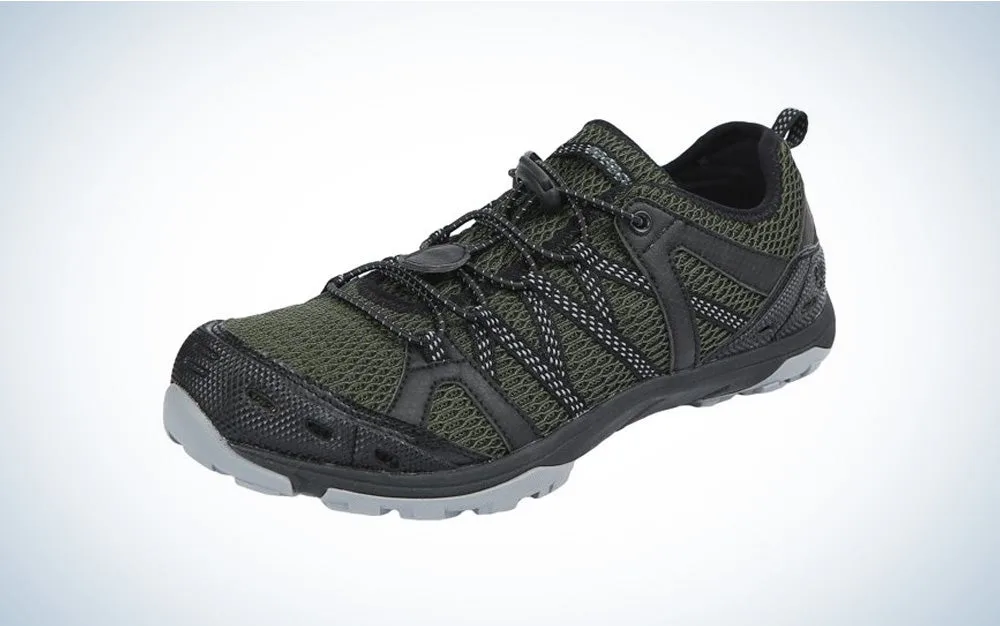
Key Features
Sizes: 8–13
Material: Mesh and embossed PU
Insole: Molded, perforated EVA
Pros
Affordable
Easy slip-on design
Comfortable for light hikes
Cons
Not a ton of arch support
Not great for wide feet
I’ve owned the Cedar Rapids for a couple of years now, and these shoes are one of my favorites to just slip on and go during the summer months. I’ve used these shoes while kayaking, hiking, fishing, swimming, and more. The Cedar Rapids are some of my favorites to slip on in a campground for a quick walk to the bathroom or camp store. These shoes have a multi-directional rubber tread which does give the shoes more dexterity over difficult terrain than you might expect.
Although it has a decent outsole and insole, my main gripe with the Cedar Rapids is that it does not offer quite as much arch support as I’d like for a hiking shoe. So don’t expect to do any major hiking with these. I have also found they are rather slow to dry unless you leave them in direct sunlight. However, for the price, they are extremely versatile.
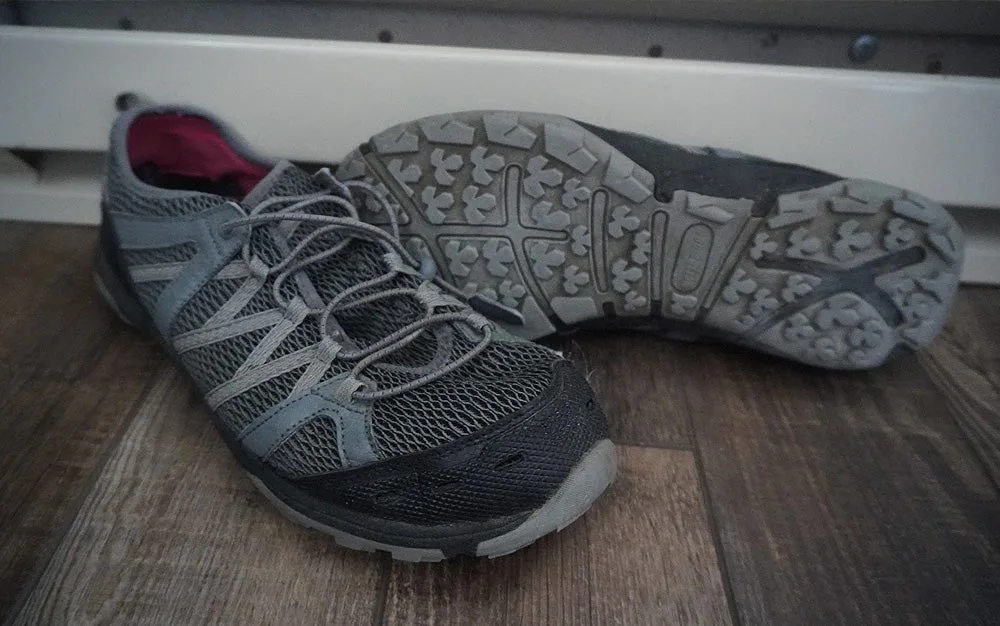
The author’s well-worn Northside Cedar Rapids water shoes. Note the wide tread pattern. Travis Smola
Best for Wide Feet: Xero Shoes Aqua X
Best for Wide Feet

Key Features
Sizes: 6.5–15
Materials: Mesh and polyurethane
Weight: 7.9 ounces each
Pros
Incredibly light
Drain holes help shed water
Wide toe box
Cons
Expensive
Minimalist style is somewhat niche
Xero Shoes has a reputation for comfort, especially for anyone who has wide feet. The Aqua X Sport has a wide toe box which users rave allows their toes to splay
, offering optimal comfort over a variety of terrain. The built-in drain holes ensure water doesn’t stay trapped inside the shoes. This helps with the breathability. These shoes are a good option for anyone who has problems with their feet sweating. Because these shoes do not have a midsole, the design is somewhat niche, and does take some getting used to for most people.
Xero Shoes purposely designed the shoes in this manner to give more of a natural barefoot feeling. However, this does give these shoes a bit more of a niche audience. The $130-$140 price tag is also on the high end for water shoes.
Best for Kayaking: Mishansha Quick Drying
Best for Kayaking

Key Features
Sizes: 3–13.5
Materials: Spandex
Weight: 9.5 ounces
Pros
Wide selection of sizes and colors
Affordable
Sole drain vents
Cons
Not for wide feet
Not true to size
These shoes took home the best overall award on our best shoes for kayaking
list because they are affordable and fast-drying. The biggest helpful feature for kayaking is the drainage holes in the soles of the shoes. This design helps drain water much faster than normal and also helps you avoid bringing water into a sit-in style kayak. Besides the excellent protection for the sizes of your feet, these shoes have a rugged outsole that grips slippery docks and rocks efficiently when landing or launching.
There are a couple downsides to these shoes. Most notably, the fact that they aren’t made for wide feet. Additionally, several Amazon reviews note these shoes
are not true to size, requiring buyers to painstakingly measure their feet before ordering. However, for the price point, these shoes are a great deal.
What to Consider When Choosing Men’s Water Shoes
When picking a pair of men’s water shoes, it’s important to consider how you’ll be using them. Although extra cushioning and arch support are great in any sort of footwear, it isn’t necessary for something you only intend to wear kayaking. On the flip side, some minimalist forms of water shoes don’t have good crossover capabilities for hiking or running, at least not without training your feet for the task first. Supportive footwear is usually more expensive too, but worth it for anyone with foot problems like plantar fasciitis.
For wading in creeks and rivers, consider something with full coverage of the foot. Many companies are introducing hybrid style water shoes that blur the lines between sandals and sneakers. While these shoes offer better breathability and ventilation, they also leave openings where rocks, sand, and sticks can enter and harm your feet.
Lastly, it’s important to know water shoes are not designed to keep your feet dry. Some buyers mistakenly choose this style of shoe thinking they will be water resistant or waterproof. However, water shoes are designed to keep your feet protected from rocks and debris hidden under the water’s surface. Your feet will get wet while wearing this type of shoe, and that’s by design. Think of it as a safer form of wading.
FAQs
Q: Do I wear socks with water shoes?
You can wear socks with water shoes, but we don’t recommend it unless they are specially made water socks. This style of footwear is designed to get wet, and adding socks to the mix can get messy if you wear traditional cotton ones. Use a sock that is designed to get wet. Additionally, you can mess up a perfectly good pair of socks beyond repair if you happen to step in a muddy spot.
Q: Can I wear water shoes to walk around in?
Water shoes are designed to be versatile, and some “crossover” pairs are designed for light hiking purposes. Although not all water shoes offer great arch support. This type of shoe is mainly designed to protect your feet from hard rocks and debris commonly found in beaches, lakes, and streams.
Q: Do water shoes keep sand out?
This depends on the shoe and the materials used in the construction. For instance, some shoes use an open design with mesh fabrics that obviously do a poor job of keeping sand out. Conversely, some water shoes are designed with a more protective, and all-encompassing design that covers more of the foot, keeping more debris out.
Best Men’s Water Shoes: Final Thoughts
Best Overall: Columbia Drainmaker IV
Best for Hiking: Saloman Crossamphibian Swift 2
Best for Rocky Beaches: Astral Loyak
Best for Fishing: Under Armour Micro G Kilchis
Best Budget: Northside Cedar Rapids Hiking Shoe
Best for Wide Feet: Xero Shoes Aqua X
Best for Kayaking: Mishansha Quick Drying
The Columbia Drainmaster IV’s combination of comfort in both the water and on the trails easily earns it the best overall title. Because of that versatility, the shoes are a great choice for anyone who takes part in a variety of outdoor activities and needs one pair of shoes that can do it all.
Why Trust Us
For more than 125 years, Field & Stream has been providing readers with honest and authentic coverage of outdoor gear. Our writers and editors eat, sleep, and breathe the outdoors, and that passion comes through in our product reviews. You can count on F&S to keep you up to date on the best new gear. And when we write about a product—whether it’s a bass lure or a backpack—we cover the good and the bad, so you know exactly what to expect before you decide to make a purchase.

